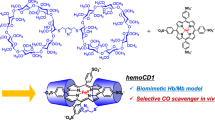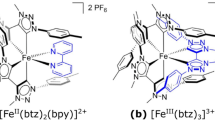Abstract
Haldane and Lorrain Smith1 discovered that carboxyhæmoglobin is sensitive to light, and several workers have shown that this property is shared by other ferrohæm–carbon monoxide compounds. Until Keilin and Hartree2 found that the cyanide compounds of ferroperoxidase and myoglobin were light-sensitive, it was generally believed that carbon monoxide compounds were unique in this respect. We have now found that oxyhæmoglobin, nitric oxide hæmoglobin and ethyl isocyanide hæmoglobin are light-sensitive, thus showing that all the known ligands able to combine with ferrohæmoglobin are qualitatively similar.
This is a preview of subscription content, access via your institution
Access options
Similar content being viewed by others
References
Haldane, J. S., and Lorrain Smith, J., J. Physiol., 20, 497 (1896).
Keilin, D., and Hartree, E. F., Biochem. J., 61, 153 (1955).
Norrish, R. G. W., and Porter, G., Disc. Farad. Soc., 17, 40 (1954).
Gibson, Q. H., J. Physiol., 134, 112 (1956).
Author information
Authors and Affiliations
Rights and permissions
About this article
Cite this article
GIBSON, Q., AINSWORTH, S. Photosensitivity of Hæm Compounds. Nature 180, 1416–1417 (1957). https://doi.org/10.1038/1801416b0
Issue date:
DOI: https://doi.org/10.1038/1801416b0
This article is cited by
-
Local changes in arterial oxygen saturation induced by visible and near-infrared light radiation
Lasers in Medical Science (2016)
-
Laser kinetic spectroscopy of the oxygenation and oxidation of hemoglobin by nitrite in rats exposed to γ-radiation
High Energy Chemistry (2000)
-
Biological applications of picosecond spectroscopy
Nature (1983)



